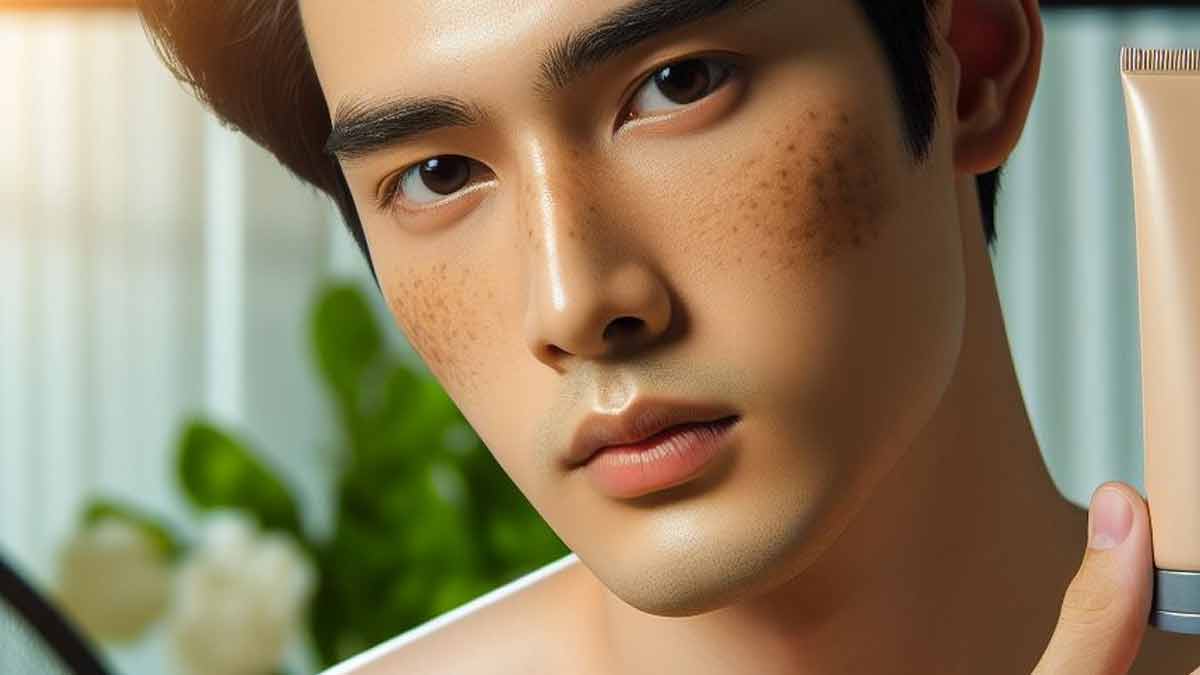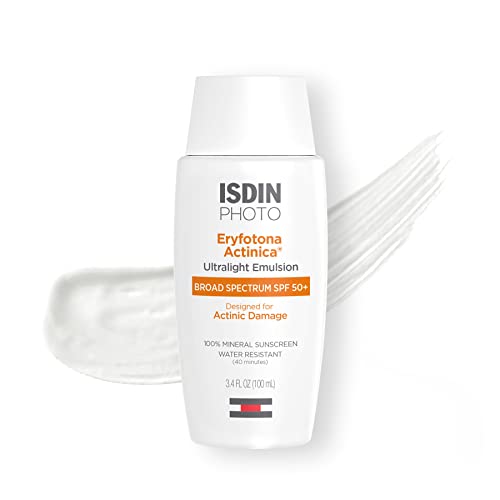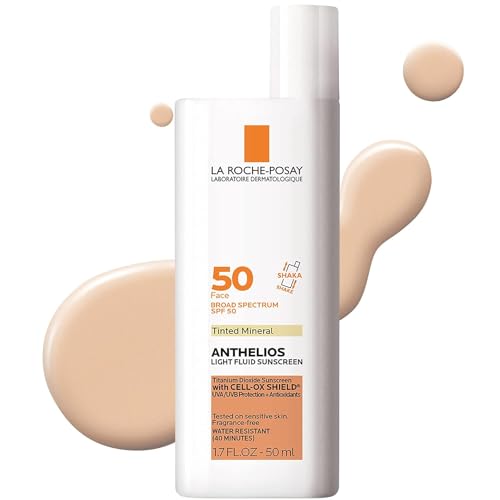Sunspots and melasma, often marked by darker or discolored patches, often worsen with exposure to the sun. Sunscreen serves as a defensive shield, protecting the skin from harmful UV rays that not only exacerbate melasma but can also lead to skin cancer.
Mineral sunscreens are particularly beneficial for those with sensitive skin or conditions like melasma, as they offer broad-spectrum protection against UVA and UVB rays, as well as protection from visible and blue light, which are known to trigger melasma. How can the right sunscreen transform your skin’s battle against melasma?
More from Glowing Gorgeous: Find out here the Best Silicone-Free Moisturizers And Why Do You Care
Glowing First Glimpse
-
- The right sunscreen can significantly improve melasma, transforming your skin’s health and appearance.
- Broad-spectrum, high SPF, and water-resistant sunscreens are essential for effective melasma management.
- Our number 1 recommendation is EltaMD UV Clear Face Sunscreen
- Combining sunscreen with other treatments like chemical peels can enhance melasma care results.
Melasma and Sun Exposure
Melasma is a common skin condition characterized by dark, discolored patches on the skin. It’s primarily triggered by hormonal changes often during pregnancy, hence its nickname ‘the mask of pregnancy’, but sun exposure can significantly worsen the condition. This is because ultraviolet (UV) rays stimulate the melanocytes, the cells responsible for producing melanin, leading to excessive melanin production and thus, darker patches.
The sun doesn’t discriminate, but it sure does exacerbate conditions like melasma. When UV light hits the skin, it’s basically a call to arms for melanin, the pigment that gives our skin, hair, and eyes their color. Ideally, melanin acts like your skin’s natural sunscreen, absorbing the harmful rays to protect your DNA from damage. But in the case of melasma, instead of an even suntan, you get uneven patches that are darker than your skin tone.
It’s crucial to distinguish between melasma, sunspots, and other forms of hyperpigmentation. While they may all look like unwelcome guests on your skin, understanding their differences is key in dealing with them efficiently. Sunspots, also known as liver spots, are usually smaller and occur in areas frequently exposed to the sun. Melasma, on the other hand, often covers larger areas and is primarily hormone-related.
This brings us to the undeniable importance of protective measures. Preventing UV damage is not just about dodging cosmetic concerns; it’s about safeguarding your skin’s health. Sunscreen, especially those formulated for sensitive skin or skin conditions like melasma, plays a crucial role in this defense.
By absorbing, reflecting, or scattering sunlight, sunscreens help keep hyperpigmentation in check and reduce the risk of skin cancer. Proactive sun protection strategies, including seeking shade, wearing protective clothing, and applying broad-spectrum sunscreen liberally, can significantly reduce the impact of sun exposure on melasma.
Physical vs. Chemical
Sunscreens are front-line defenders in the battle against UV radiation, vital for maintaining skin health and managing conditions like melasma. Broadly classified into two types – physical (mineral) and chemical – each serves the same purpose but operates differently. Physical sunscreens act as a shield on the surface of the skin, deflecting UV rays away.
The stalwarts in this category, zinc oxide and titanium dioxide, are particularly beneficial as they provide broad-spectrum protection against both UVA and UVB rays, making them a favored choice for sensitive skin or skin conditions like melasma. They’re less likely to cause irritation, making them suitable for all skin types, including those prone to acne or rosacea.
On the flip side, chemical sunscreens absorb into the skin and then absorb UV rays, convert the rays into heat, and release them from the body. There’s growing concern among users about the potential absorption of chemical sunscreen ingredients into the bloodstream. Some studies have prompted discussions regarding the safety and long-term effects of these chemicals, highlighting the need for thorough understanding and cautious selection based on individual health and skin requirements.
For those with sensitive skin or conditions like melasma, a mineral sunscreen such as Supergoop Zincscreen 100% Mineral Lotion SPF is an excellent choice.
Supergoop Zincscreen is crafted specifically with melasma and sensitive skin in mind. Its 100% mineral formula, featuring zinc oxide, offers robust sun protection while minimizing potential skin irritation. Unlike many chemical sunscreens, it sits on the skin’s surface to reflect away damaging UV and even high-energy visible (HEV) light, which can also exacerbate melasma. This makes it a standout option for those seeking effective sun protection without compromising skin health.
Choosing the right sunscreen for melasma doesn’t have to be a daunting task. We all know the sun can be both a friend and a foe, especially when it comes to our skin. For those with melasma, a condition characterized by dark, discolored patches on the skin, safeguarding against UV rays becomes not just a cosmetic concern but a necessity. A broad-spectrum SPF offers a shield against both UVA and UVB rays, crucial since UV exposure can exacerbate melasma.
More from Glowing Gorgeous: Find out here Hyram’s Recommended Face Sunscreens For The Summer
Sunscreen with an SPF of at least 30 is recommended for everyday use, although bumping it up to SPF 50 provides even better protection without the need for frequent reapplication. This is particularly essential when spending extended periods outdoors, whether you’re running errands or lounging at the beach. Moreover, opting for a water-resistant sunscreen can extend the duration of protection, especially during activities that involve sweating or swimming.
Let’s talk about what goes on or, more accurately, doesn’t go into your pores. Non-comedogenic sunscreens are designed to prevent the clogging of pores, a critical consideration for all skin types but especially for those with sensitive skin or skin conditions like melasma. The last thing anyone wants is sunscreen that betrays by worsening skin issues. Therefore, choosing sunscreens formulated to be light on the skin while offering solid protection against the sun is key.
For those particularly sensitive to the sun, looking into tinted sunscreens could be beneficial. Tinted sunscreens not only shield the skin from UV rays but also from visible light, which can worsen melasma. A top pick in this category is the Sunforgettable Total Protection Face Shield SPF 50.
This remarkable product offers a trifecta of benefits: it’s mineral-based, which means it uses zinc oxide and titanium dioxide for sun protection; it’s tinted, providing not just protection but also a uniform skin tone appearance; and it boasts a broad spectrum SPF 50, granting robust protection against the sun. The addition of antioxidants like vitamin E makes it a super pick for nourishing the skin while shielding it from potential damage.
In short, when scouting for the best sunscreen to protect your skin from melasma, focus on broad-spectrum SPF products, preferably mineral-based with zinc oxide or titanium dioxide. Prioritize sunscreens with a high SPF level for extended outdoor activities, and always opt for water-resistant and non-comedogenic formulas to keep your skin happy and healthy. For added protection against visible light, tinted sunscreens are your best bet. With these guidelines in mind, you can enjoy the sun without risking your skin’s health.
Choosing the right sunscreen for melasma can be a tricky affair. It’s not just about blocking UV rays but also offering protection against visible light while catering to the unique needs of your skin. Here, I’ll take you through some of the top-rated sunscreens known for their effectiveness in melasma management. Whether you’re after a mineral formulation or a tinted version that evens out your skin tone, there’s something for everyone.
EltaMD UV Clear Face Sunscreen is another gem, particularly for those with sensitive or oily skin. Its lightweight formula doesn’t clog pores, a huge plus for anyone wary of aggravating their skin condition. With ingredients like zinc oxide, niacinamide (vitamin B3), and hyaluronic acid, it not only shields your skin from UVA and UVB rays but also nurtures it. The inclusion of niacinamide is significant, as it can help in reducing the appearance of dark spots and soothing skin inflammation.
CeraVe Hydrating Sunscreen Sheer Tint Lotion is your go-to option if you lean towards mineral sunscreens with a bonus of hydration. This product combines zinc oxide and titanium dioxide to protect against UV radiation, while hyaluronic acid and ceramides keep your skin moisturized. The sheer tint cleverly blends into your skin tone, eliminating any fears of a white cast. It’s a beautiful balance between sun protection and skin care, making it a fabulous pick for individuals with melasma.
For an option that flies a bit under the radar, ISDIN Eryfotona Actinica Zinc Oxide and 100% Mineral Sunscreen has garnered rave reviews from customers for its effectiveness against melasma without leaving any residue on the skin. What sets this sunscreen apart is its completely invisible finish, making it ideal for every skin tone. Customers appreciate its lightweight, non-greasy formula, and how it doubles as a makeup-gripping primer.
When it comes to Korean sunscreens, which are celebrated for their advanced formulations and skin benefits, the MISSHA All Around Safe Block Essence Sun Milk stands out. It’s noted for its hydrating properties and high level of protection against UV rays and blue light, making it a top pick for those battling melasma. Its lightweight and non-sticky formula ensure comfort and protection, seamlessly fitting into any skin care routine.
For those preferring tinted sunscreens, the Sunforgettable Total Protection Face Shield SPF 50 is a fantastic choice. Not only does it offer broad-spectrum protection against UV rays and pollution, but its tinted formula also works wonders in evening out skin tone. This product can be particularly beneficial for individuals looking to address hyperpigmentation while safeguarding their skin from further damage.
In summary, when dealing with melasma, the key is to choose a sunscreen that offers broad-spectrum protection, suits your skin type, and, if needed, provides a tint to help even out skin tone. Products like CeraVe Hydrating Sunscreen Sheer Tint Lotion and EltaMD UV Clear Face Sunscreen are excellent options, each bringing something unique to the table. On the other hand, Supergoop Unseen Sunscreen and MISSHA All Around Safe Block Essence Sun Milk offer cutting-edge formulas that cater to those seeking invisible or hydrating options. And for tinted protection, the Sunforgettable Total Protection Face Shield SPF 50 remains a top recommendation.
Application Tips for Maximum Protection
Applying sunscreen might seem straightforward, but when it comes to fighting off melasma, there are a few tricks to improve its efficacy. First, ensure you’re using a product that offers broad-spectrum SPF protection to guard against both UVA and UVB rays, imperative for preventing dark spots and skin damage. For those battling melasma, opting for a sunscreen that includes ingredients like zinc oxide or titanium dioxide provides a physical barrier against not only UV radiation but also visible and blue light, which can exacerbate pigmentation issues.
Another key point is the reapplication of sunscreen throughout the day, which can’t be overstated. Sunscreen should be reapplied every two hours, or more frequently if you’re swimming or sweating. This is where integrating sun protection into your daily skincare regime becomes crucial. Consider using moisturizers with SPF or layering sunscreen under makeup to ensure continuous protection.
Speaking of makeup, many products now come with added SPF. While these aren’t a replacement for dedicated sunscreens, they can offer additional protection, particularly from visible light which some makeup products are designed to reflect. This is especially pertinent for individuals with sensitive skin or those concerned about adding too many layers to their skincare routine. It’s also worth mentioning that even on cloudy days or when you’re indoors, UV rays and visible light can still affect your skin, making daily application of sunscreen an essential habit for those looking to manage their melasma effectively.
Combining sunscreen with other treatments can really lift your skin care routine, especially for those dealing with the stubborn dark patches that come with melasma. One effective ally in the battle against melasma is the chemical peel. As research, including a comprehensive review published on the National Institutes of Health’s website, suggests, peels can significantly reduce the visibility of melasma.
However, as chemical peels strip away the top layer of skin to reveal new, less pigmented layers beneath, your skin becomes more vulnerable to UV damage. This is where a good, broad-spectrum sunscreen steps in, essentially serving as a shield while your skin is in its most sensitive state post-treatment.
After a chemical peel, or any other melasma treatment, following up with products meant to nurture and protect your skin is crucial. This includes serums rich in vitamin C and E, known for their antioxidant properties and ability to lessen pigmentation. Vitamin C, in particular, has been regarded as a staple in post-treatment care for its role in collagen synthesis and its potential to reduce the appearance of dark spots when used consistently. Sunscreen, however, remains the non-negotiable step in this routine. Not only does it protect your newly revealed layer of skin from immediate damage, it also ensures that the results of your treatment last longer.
In this realm, mineral sunscreens containing zinc oxide or titanium dioxide are highly recommended for those with melasma. These ingredients create a physical barrier that deflects the sun’s rays away from the skin, rather than absorbing them like chemical sunscreens do. Mineral formulations are less likely to irritate sensitive skin, which is a common concern post-peel or for those undergoing other forms of melasma treatment. Among the top picks for post-treatment care is Eau Thermale Avène Solaire.
A real standout, Eau Thermale Avène Solaire UV Mineral Multi-Defense Sunscreen offers a broad spectrum SPF, ensuring protection against both UVA and UVB rays, as well as against blue light and pollution. This is particularly important for melasma sufferers, as both UV and visible light have been shown to exacerbate the skin condition.
Formulated with zinc oxide, it provides a physical block against sun damage, while antioxidants help to repair and protect the skin. Given its gentle, mineral-based formulation, it’s suitable for use on sensitive skin following chemical peels or other similar treatments.
Combining effective melasma treatments like chemical peels with diligent use of sunscreen and post-treatment care can significantly improve skin condition and prevent further pigmentation. Incorporating elements like zinc oxide, vitamin C, and vitamin E into your skincare regimen not only supports the healing process but also maximizes protection against factors that may worsen melasma. Always remember, while treatments can reduce pigmentation, consistent sun protection is vital in preventing its recurrence and maintaining healthy, even-toned skin.
Common Concerns and FAQs
One question I hear a lot revolves around whether all sunscreens are effective against melasma. Not all sunscreens are created equal—look for broad spectrum SPF products that protect against both UVA and UVB rays, as both contribute to skin damage and pigmentation issues. Ingredients like zinc oxide and titanium dioxide in mineral sunscreens scatter UV radiation away from the skin, providing a physical barrier that is particularly effective for those dealing with melasma.
Amid the swirl of information out there, a concern arises: does sunscreen actually cause hyperpigmentation or worsen melasma? The simple answer is no. However, chemical sunscreens with ingredients that absorb UV radiation can sometimes irritate sensitive skin, potentially leading to inflammation that exacerbates hyperpigmentation. This is why mineral sunscreens are often recommended—they offer protection without the risk of irritation.
For those anticipating or nursing a baby, the safety of sunscreen application becomes a poignant concern. Mineral sunscreens are generally considered safe during pregnancy as they sit on top of the skin rather than being absorbed. Zinc oxide and titanium dioxide are the go-tos here, avoiding chemical filters that might raise questions.
Lastly, let’s not overlook the power of antioxidants such as vitamin C and E in the fight against hyperpigmentation. Not only do they help in preventing sunspots by neutralizing free radicals, but they also work alongside sunscreen to improve its efficacy. Serums rich in these antioxidants can significantly boost skin’s resilience against UV damage and aid in fading existing pigmentation.
Bottom Line
In the quest for flawless skin, understanding and managing melasma is vital. The core element in this journey is sunscreen. Employing the right sunscreen—preferably mineral-based options containing zinc oxide or titanium dioxide, can dramatically aid in reducing exposure to harmful UV rays, visible light, and even blue light, which are known culprits in the exacerbation of melasma and other forms of hyperpigmentation.
It’s not just about slathering it on once and calling it a day; reapplication is vital, especially after sweating or swimming, even if you’re indoors most of the day. For those wrestling with this skin condition, integrating a broad-spectrum SPF into your daily skin care routine, tailored to your skin type and coupled with antioxidants like vitamins C and E, can not only provide protection but also significantly improve the appearance of dark spots.
The introduction pondered on the transformative potential of appropriate sunscreen use, and the answer is resoundingly affirmative. Regular and diligent application of the right sunscreen can transform your skin care journey, providing an effective shield against the elements that fuel melasma and setting a foundation for healthier, more radiant skin.


 Supergoop! Zincscreen - 1.7 fl oz - SPF 40 PA+++ 100% Mineral Face Lotion &...
Supergoop! Zincscreen - 1.7 fl oz - SPF 40 PA+++ 100% Mineral Face Lotion &... Colorescience Total Protection Face Shield SPF 50, 1.8 Fl Oz
Colorescience Total Protection Face Shield SPF 50, 1.8 Fl Oz EltaMD UV Clear Face Sunscreen, SPF 46 Oil Free Sunscreen with Zinc Oxide,...
EltaMD UV Clear Face Sunscreen, SPF 46 Oil Free Sunscreen with Zinc Oxide,... CeraVe Hydrating Mineral Sunscreen with Sheer Tint | Tinted Mineral Sunscreen...
CeraVe Hydrating Mineral Sunscreen with Sheer Tint | Tinted Mineral Sunscreen... ISDIN Eryfotona Actinica Zinc Oxide and 100% Mineral Sunscreen Broad Spectrum...
ISDIN Eryfotona Actinica Zinc Oxide and 100% Mineral Sunscreen Broad Spectrum... MISSHA All Around Safe Block Essence Sun Milk SPF50+ /PA+++ 70ml I Hydrating...
MISSHA All Around Safe Block Essence Sun Milk SPF50+ /PA+++ 70ml I Hydrating... Colorescience Sunforgettable Total Protection Face Shield Bronze SPF 50, 1.8 Fl...
Colorescience Sunforgettable Total Protection Face Shield Bronze SPF 50, 1.8 Fl... Eau Thermale Avène Solaire UV Mineral Multi-Defense Sunscreen Fluid SPF 50+ -...
Eau Thermale Avène Solaire UV Mineral Multi-Defense Sunscreen Fluid SPF 50+ -...
 La Roche-Posay Anthelios Melt-In Milk Body & Face Sunscreen SPF 60, Oil Free...
La Roche-Posay Anthelios Melt-In Milk Body & Face Sunscreen SPF 60, Oil Free... La Roche-Posay Anthelios Tinted Sunscreen SPF 50, Ultra-Light Fluid Broad...
La Roche-Posay Anthelios Tinted Sunscreen SPF 50, Ultra-Light Fluid Broad... innisfree Daily UV Defense Sunscreen Broad Spectrum SPF 36 Face Lotion, 1.69 Fl...
innisfree Daily UV Defense Sunscreen Broad Spectrum SPF 36 Face Lotion, 1.69 Fl...
Comments